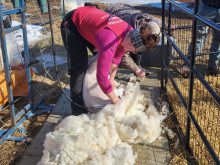LETHBRIDGE, Alta.- Last summer was the year of the arachnid in southern Alberta.
Rarely seen species of spiders and scorpions were prolific as they munched on an outbreak of insect pests encouraged by a hot, dry
summer.
“This was biggest year in probably 30 years for arachnids,” said Agriculture Canada entomologist Dan Johnson.
He said the spiders were attracted by infestations of grasshoppers, armyworms, cabbage seed pod weevils, lygus bugs and wheat sawflies.
Speaking at the Agronomy Update 2001 conference held Jan. 17 in Lethbridge, Johnson said most of southern Alberta’s insect problems in 2000 were brought on by good moisture in April followed by hot, dry weather. Last year was the driest in southern Alberta since 1918.
Read Also

Charges laid after cattle theft
Saskatchewan RCMP lay two charges against a man after six cattle went missing.
Insects need moisture to complete early development and heat makes it easier to pass through each life cycle.
Johnson said farmers can expect more grasshoppers this summer if the weather is warm and dry.
Some of the thousands of grasshopper species do not need water to survive because they can convert carbohydrates into fat, which then breaks down into water.
“It can be pretty hard to beat them,” he said.
Lloyd Dosdall of Alberta Agriculture said cabbage seed pod weevils have increased exponentially since 1999, causing $5 million in damage in southern Alberta last year.
“These insects are voracious feeders trying to build up their fat storage for winter,” Dosdall said.
They are moving eastward at the rate of 60 kilometres a year. They should be found throughout Alberta and halfway across southwestern Saskatchewan by 2005.
Canola is their main target, but they also live in flixweed, stinkweed, volunteer canola and hoary cress.
There is no parasite available to combat weevils, so emergency approved insecticides have been used for the last two years. Lorsban and Decis were sprayed on 5,000 acres in 1999 and on 75,000 acres last year. It is hoped the insecticides will receive full approval in 2001.
The wheat stem sawfly reappeared in 1998 after a 10-year absence.
“In 2000 there was a bit of a population explosion,” said Brian Beres of Agriculture Canada.
“We can safely assume we’re going to have a sawfly problem in 2001. Several years are required before you see any significant decline in population.”
The female can lay up to 50 eggs on one wheat stem. Larvae hatch throughout the summer and overwinter in cocoons, often in stubble.
They leave behind shriveled kernels and weakened stems that easily topple over. Fallen plants cost up to $16 per acre in lost yield.
Plant breeders are looking at solid-stemmed plants to prevent the sawfly from invading. Barley, oats and legumes are resistant to sawflies and are good alternatives to wheat.
Four species of lygus bugs have been detected in Alberta canola fields, said Hector Carcamo of Agriculture Canada.
They are oval-shaped bugs with antenna about half their body length.
“Both the adults and the nymphs are pests,” Carcamo said.
They damage canola plants starting at the bud and flower stages.
It is likely that the insect is encouraged by mild winters, warm dry springs and long, warm falls.
Farmers are advised to spray if the number of bugs caught in sweep nets exceeds a specific level.
Carcamo suggests 10 sweeps in 10 different spots in a field. Dylox, Lorsban and Matador 120 EC are the registered insecticides.

















